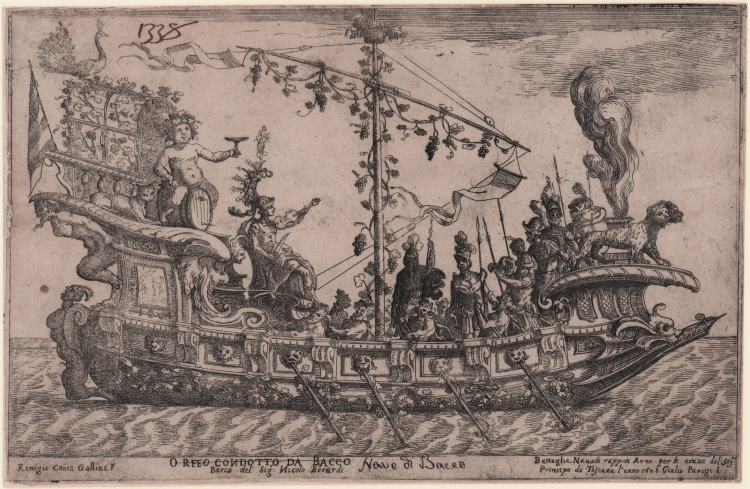




| Reference: | S17088 |
| Author | Remigio CANTAGALLINA |
| Year: | 1608 |
| Measures: | 283 x 170 mm |



| Reference: | S17088 |
| Author | Remigio CANTAGALLINA |
| Year: | 1608 |
| Measures: | 283 x 170 mm |
Etching, 1608, inscribed lower centre: Orfeo Condotto da Bacco/ Barca del. Sig. Nicolo Berardi (Orpheus Lead by Bacchus, Sig. Nicolo Berardis Ship); in lower right 'Battaglia navale rapp in Arno per le nozze del Ser. Principe di Toscana l'anno 1608 Giulio Parigi I', and in lower left 'Remigio Canta Gallina F'.
From the series Ships of the Argonauts, a set of 19 plates almost entirely by Cantagallina (Bartsch 20-38) showing the various vessels designed by Parigi and Ligozzi, each under the command of an Argonaut, that were constructed and fought on the Arno as part of the wedding festivities at the marriage of Cosimo de' Medici, Grand Duke of Tuscany, and Maria Magdalena of Austria on 3 November 1608 designed by Giulio Parigi to celebrate the weddingof Cosimo II, and Marie Madelaine of Austria
Highly decorated boat with oars coming out of lions’ mouths on the sides, figures incostume, one as Orpheus with his violin seated high in center rear, on the high stern a chubby figure of Bacchus astride a wine cask and holding a glass
Beautiful work, printed on contemporary laid paper without watermark, trimmed to the platemark, a few writings realized with ancient ink, otherwise in excellent condition.
|
Bartsch 31.
|
Remigio CANTAGALLINA (Borgo San Sepolcro, 1582 circa; Florence, 1656).
|
Italian etcher and draughtsman. He did not study at the ‘academy’ of Giulio Parigi in Florence, as has been claimed, although he did collaborate with the architect in 1608 when he engraved prints of two of Parigi’s theatre sets. His first documented work is from 1603, the date of a series of landscape etchings. Northern influences in his early prints can be traced to Paul Bril, but his way of creating perspective by the intensification of shadow is reminiscent of Antonio Tempesta. It is significant that Cantagallina was one of the first artists to abandon the late-Mannerist vision of nature as fantastic and frightening for a genuine interest in themes from daily life. Among his most notable drawings are the splendid Village Piazza and the large View of Siena (Florence, Uffizi). In 1612–13 he was in the Netherlands, where he produced such detailed drawings as the Palace of Brussels and Sulphur-making at Franc Mont (both Brussels, Musées Royaux B.-A.). Some of his etchings also are known: the Death of St Francis (1605); Bona, City of Barbary (1607); four etchings on biblical subjects (1609); a series of 14 landscapes (1627; London, BM); and 12 undated landscapes (Vienna, Albertina). His last known engraving dates from 1635, a Landscape with Travellers that is notable for the delicacy of its execution and for the masterly handling of space. The latest drawing (Florence, Uffizi) is dated 1655.
|
|
Bartsch 31.
|
Remigio CANTAGALLINA (Borgo San Sepolcro, 1582 circa; Florence, 1656).
|
Italian etcher and draughtsman. He did not study at the ‘academy’ of Giulio Parigi in Florence, as has been claimed, although he did collaborate with the architect in 1608 when he engraved prints of two of Parigi’s theatre sets. His first documented work is from 1603, the date of a series of landscape etchings. Northern influences in his early prints can be traced to Paul Bril, but his way of creating perspective by the intensification of shadow is reminiscent of Antonio Tempesta. It is significant that Cantagallina was one of the first artists to abandon the late-Mannerist vision of nature as fantastic and frightening for a genuine interest in themes from daily life. Among his most notable drawings are the splendid Village Piazza and the large View of Siena (Florence, Uffizi). In 1612–13 he was in the Netherlands, where he produced such detailed drawings as the Palace of Brussels and Sulphur-making at Franc Mont (both Brussels, Musées Royaux B.-A.). Some of his etchings also are known: the Death of St Francis (1605); Bona, City of Barbary (1607); four etchings on biblical subjects (1609); a series of 14 landscapes (1627; London, BM); and 12 undated landscapes (Vienna, Albertina). His last known engraving dates from 1635, a Landscape with Travellers that is notable for the delicacy of its execution and for the masterly handling of space. The latest drawing (Florence, Uffizi) is dated 1655.
|